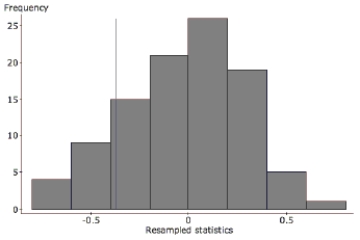Time Wasted A group of students decide to see if there is link between wasting time on the internet and GPA. They don't expect to find an extremely strong association, but they're hoping for at least a weak relationship. Here are the findings.
a. How strong is the relationship the students found? Describe in context with statistical justification.
One student is concerned that the relationship is so weak, there may not actually be any relationship at all. To test this concern, he runs a simulation where the 10 GPA's are randomly matched with the 10 hours/week. After each random assignment, the correlation is calculated. This process is repeated 100 times. Here is a histogram of the 100 correlations. The correlation coefficient of -0.371 is indicated with a vertical line. 
b. Do the results of this simulation confirm the suspicion that there may not be any relationship? Refer specifically to the graph in your explanation.
Definitions:
Anal Stage
The second stage in Freud's psychosexual development theory, occurring roughly between the ages of 18 months and three years, where the focus of pleasure is on the anus.
Psychosexual Stages
The stages of psychological development theorized by Freud, through which a child progresses from infancy to adulthood, each characterized by a different focus of libido (sexual energy).
Fixated
A psychological term referring to the state of being obsessively focused or attached to an emotional experience or person from one's past.
Oral Stage
The first of Freud's psychosexual development stages, occurring from birth to about 18 months of age, where pleasure centers on the mouth.
Q15: One of the reasons that the Monitoring
Q24: Hardwood mulch Hardwood mulch is sold
Q25: Does the value of s concern you?
Q26: A lakeside restaurant found the correlation between
Q47: The SPCA has kept these data records
Q85: What is the marginal distribution of age
Q92: A residuals plot is useful because<br>I. it
Q93: Announcements. A high school in Wisconsin stopped
Q96: We have calculated a confidence interval based
Q100: To see if your school's ACT scores